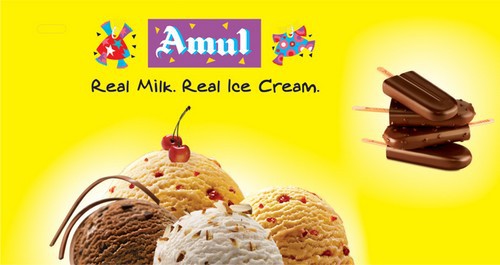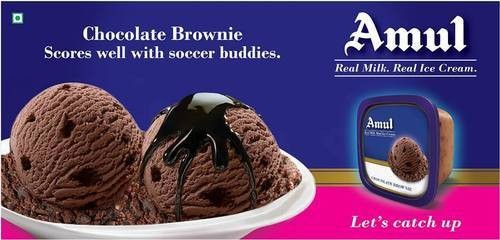The Marketing mix of Amul Ice Cream analyses the 4Ps of Amul Ice Cream, including the Product, Price, Place, and Promotions. Amul Ice Cream is a subsidiary of its parent company Amul. It is associated with the food industry as it deals in frozen dairy products. Amul is a cooperative of Indian origin founded in 1946 by its founder, Tribhuvandas Patel. Amul Ice Cream was started by Amul in 1996, and by 1999, it was readily available in most parts of the country. Amul Ice Cream is ranked among India’s top five ice cream brands. It faces stiff competition from several rival ice cream brands, like
- Vadilal Ice Cream
- Baskin Robbins
- Kwality Ice Cream
About Amul Ice Cream
- Type: Ice cream brand.
- Industry: Food and beverage.
- Founded: 1946.
- Founders: Dr. Verghese Kurien and the Gujarat Cooperative Milk Marketing Federation.
- Headquarters: Anand, Gujarat, India.
- Area served: India and other parts of the world.
- Current CEO: R. S. Sodhi.
- Number of employees: Over 60,000.
- Major products: Amul Ice Cream is available in a variety of flavors, including vanilla, Chocolate, strawberry, mango, and coffee
Table of Contents
Amul Ice Cream Product Strategy
Amul is an established brand in India with a substantial market value. It is one of the most popular and desirable brands in terms of dairy products. Amul Ice Cream has a lot of variants in its product kitty to tempt its consumers, like Kulfi, cones, pack tubs, cups, ice candies, sticks, ice creams, chocolate bars, and ice candies.
These ice creams are readily available in different flavors like strawberry, litchi, and pasta and sizes like 120ml and 50 ml, bulk family packs, family packs, and combo family packs to suit individual needs. In 2007, the company introduced sugar-free ice cream for health-conscious consumers. Amul is a trusted brand; its ice creams are made from fresh and natural milk. The calcium and protein content makes it a nutritional product. Packaging any item is essential, and Amul ice cream packaging is beautiful.
Amul Ice Cream, known for its variety and quality, offers a diverse product portfolio and a marketing mix of Amul ice cream catering to different tastes and preferences.
The new Product Mix of Amul Ice Cream in 2023 is as follows (Source).
- Classic Flavors: Includes traditional flavors like Vanilla, Chocolate, Strawberry, Butterscotch, and Mango. These are available in different formats, like cups, cones, bars, and family packs.
- Premium Flavors: Amul offers a range of premium flavors such as Belgian Chocolate, Alphonso Mango, Roasted Almond, and more. These are often made with high-quality ingredients and provide a gourmet ice cream experience.
- Sugar-Free Ice Creams: Catering to health-conscious consumers or those with dietary restrictions, Amul has sugar-free ice creams that are lower in calories but still deliver on taste.
- Traditional Indian Flavors: Amul incorporates Indian dessert flavors into its ice cream range, with options like Kulfi, Shahi Anjeer, Rajbhog, and Kesar Pista.
- Novelty Ice Creams: This includes various fun and innovative products like ice cream sandwiches, ice cream cakes, and chocolate bars, appealing particularly to younger consumers.
- Fruit Ice Creams: These are made with authentic fruit pieces and include flavors like Litchi, Black Currant, Raspberry, and more, offering a refreshing choice for fruit lovers.
- International Flavors: Amul also offers flavors inspired by international desserts, such as Swiss Chocolate, French Vanilla, and Italian Hazelnut, catering to a palate looking for global tastes.
- Ice Cream Tubs and Bulk Packs: For family or group consumption, Amul provides more giant tubs and bulk packs of various flavors, suitable for parties and gatherings.
- Diet Ice Creams: These are specially formulated to be lower in fat and calories, targeting consumers who are watching their diet but still want to enjoy a frozen treat.
- Seasonal Specials: Amul occasionally introduces seasonal specials based on local fruits and festivals, offering unique flavors for a limited time.
Amul’s diverse product portfolio and marketing mix allow Amul Ice Creams to cater to a wide range of consumer tastes and preferences, making it a popular choice in the ice cream market.
Amul Ice Cream Place Strategy
Amul Ice Cream is available in most cities and towns of India as its product has a Pan-India presence. It includes famous ice cream brands in the cities like Mumbai, Kolkata, Bangalore, Ahmedabad, Pune, Chandigarh, Chennai, and Delhi, as well as cities like Rohtak, Nohar, Rajgarh, Burdwan, Durgapur, and Darjeeling. The head office of Amul Ice Cream is established at Anand in Gujarat. Amul Ice Cream is manufactured at HACCP and ISO-certified state-of-the-art factories with absolute hygienic standards to ensure food safety.
The brand has a well-spread distribution network that helps transfer dairy products from manufacturing outlets to retail outlets. Amul Ice Cream has taken the help of the distribution channel set up by its parent company. It includes procurement channels responsible for collecting the ingredients from dairy cooperatives and other sources and the distribution channel that helps distribute its end-products via C&F agents, distributors, suppliers, retailers, and dealers to the retail outlets in direct contact with consumers. It has such a solid and robust distribution channel that its dairy products reach the consumer market easily in most parts of the country.
Amul Ice Creams are sold in various retail outlets, exclusive parlors, retail outlets, discount stores, hotels, canteens, restaurants, café, supermarkets, fast-food joints, clubs, and shopping malls. Amul has its retail outlets where it sells its products exclusively. In some cities, vendors sell Amul Ice Cream via mobile vans and carts.
Here’s Amul Ice Cream’s place strategy.
- Wide Retail Distribution: Amul Ice Creams are available across India through a vast network of retailers, ranging from small local shops to supermarkets, ensuring easy accessibility for customers in both urban and rural areas.
- Amul Ice Cream Parlours: Amul operates exclusive ice cream parlors that offer an extensive range of Amul Ice Cream products. These parlors are strategically located in high-footfall areas like shopping malls, commercial streets, and tourist spots to attract a diverse customer base.
- Online Delivery and E-commerce Platforms: Recognizing the growing trend of online shopping, Amul Ice Creams are available on various e-commerce platforms and can be ordered through online food delivery services, catering to the convenience of digital-savvy consumers.
- Partnership with Food Outlets and Restaurants: Amul collaborates with various food outlets, restaurants, and cafes to offer ice creams as desserts. This partnership increases visibility and integrates Amul Ice Cream into the dining experience.
- Seasonal and Event-Based Availability: Amul strategically increases its presence in places like fairs, festivals, and seasonal markets (like during the summer) through temporary kiosks or tie-ups with event organizers, capitalizing on the seasonal spike in ice cream consumption.
Amul Ice Cream Pricing Strategy
Amul Ice Cream has kept a market-oriented pricing policy for selling its products. Amul Ice Creams and Cream is a brand that believes in mass consumption, and all its product prices are kept at such levels that its consumers can easily purchase them.
At its onset, Amul Ice Cream adopted a penetration pricing policy and kept low-cost pricing, its product prices marginally lower than the prices of its rival brands. The brand has maintained its low-cost pricing strategy to advance in new markets quickly. Amul Ice Cream also offers periodic discounts and incentives to attract customer interest and increase its sales. It believes in bulk sales and generally offers incentives on bulk packs.
As it became popular and faced competition from competitors, it adopted a competitive pricing strategy and kept product prices affordable and reasonable. Recently, it launched its EPIC Ice Cream a day before the launch day of the same type of Ice Cream of its rival brand and kept its epic ice cream prices much lower even when they both had the same primary ingredient, Belgian Chocolate, which made epic ice cream of them unique. This immensely helped Amul’s cause to a great extent and resulted in mass sales.
Amul Ice Cream’s pricing strategy and marketing mix reflect a well-crafted approach that balances consumer appeal with market dynamics. The key aspects and marketing mix of Amul Ice Cream and their pricing strategy:
- Competitive Pricing: Amul Ice Creams are priced competitively to align with the market rates, ensuring they remain an attractive choice for consumers. This strategy is essential in the highly competitive ice cream market, where price can significantly influence consumer choice.
- Value-Based Pricing: Amul Ice Creams are priced based on the perceived value they offer. Premium flavors and specialty products are priced higher, reflecting their unique offerings and higher-quality ingredients. This approach appeals to consumers seeking a premium ice cream experience.
- Psychological Pricing: Amul often employs psychological pricing tactics, setting prices slightly below a round figure (e.g., ?99 instead of ?100). This strategy makes the price appear more attractive and can encourage impulse purchases, especially for lower-priced products like single-serve ice creams.
- Product Line Pricing: Amul strategically prices its diverse range of ice creams to encourage customers to try different products. Primary flavors are more affordable, while exotic or premium flavors have a higher price tag. This segmentation allows Amul to cater to a wide range of customers, from those seeking affordable treats to those willing to pay more for unique flavors.
- Promotional Pricing: Amul occasionally adopts promotional pricing strategies, such as discounts, combo offers, or seasonal price reductions. These tactics are particularly effective in attracting price-sensitive customers and boosting sales during off-peak seasons or special events.
- Cost-Plus Pricing for Institutional Sales: For bulk and institutional sales, like to restaurants or event caterers, Amul likely uses a cost-plus pricing strategy. This involves adding a standard markup to the production cost, ensuring profitability while offering competitive rates for large-volume purchases.
- Dynamic Pricing for Seasonal Variations: Recognizing the seasonality of ice cream consumption, Amul might adjust prices in peak seasons like summer or during festivals to maximize sales and profitability.
Amul Ice Cream has catered to a diverse consumer base through this multifaceted pricing approach, maintaining its stronghold in the Indian ice cream market while ensuring profitability, low-cost pricing, and market competitiveness.
Amul Ice Cream Promotion Strategy
Amul has adopted several marketing strategies to market its products in the consumer market. Its above-the-line marketing is less than its below-the-line policy for marketing strategies advertising its products because it does not want to overspend on its marketing strategies.
It is an established brand with very heavy footfall. The brand advertises via radio, television, newspapers, magazines, hoardings, and billboards through its most extended and unique brand ambassador and advertising character, The Amul Girl. According to the brand and media reports, Amul Ice Cream does not believe in other celebrity endorsements, as its poster of Amul Ice Cream Girl is the best advertisement tool.
Amul Ice Cream participates in several events, like distributing free products during school events or sports days. It believes in sales promotion activities, discount schemes, and trade promotions. Several discount options like 20% extra and one free with others are its favorite marketing mix strategy.
It has received several awards and recognition for its efforts. In 2007, its product Amul and Pro-Biotic Ice Cream, which is sugar-free and sugar-free, won The International Dairy Federation Marketing Award.
Some Recent Video ads and Print ads for Amul Ice Cream are:
Liked this post? Check out the complete series on Marketing Mix

